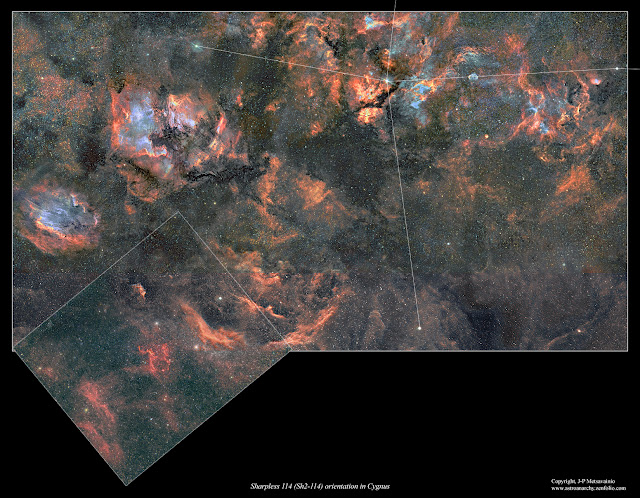COPYRIGHT, PLEASE NOTE
Monday, January 11, 2021
First new photo for the Year 2021
Between Cygnus and Cepheus, near the constellation Lacerta, locates the Sharpless 124 (Sh2-124)
This emission nebula is kind of large and has a brighter formation at middle of it. There is some very dim O-III emission too, generally this emission nebula is not a very easy target for imagers.
There are very few good phoptos of it around.
My wide field setup covers enough sky to capture both, the Cocoon Nebula (Sh2-125) and the Sharpless-124 in a same field of view. Data for the photo was shot at December 2020
Click for a large image
A closeup
Click for a large image
An older longer focal length photo
Click for a large image
5nm H-alpha 3nm S-II and 3nm O-III
Thursday, December 31, 2020
All my photos from year 2020
The year 2020 has been interesting since I'm between the scopes at the moment. I converted my old Tokina At-x 300 mm f2.8 camera optics and paired it with the Apogee Alta U16 astro camera.
At first it looked like an impossible task since the back focus distance of Tokina lens was way too short for the camera. After some heavy handed modifications (including an angle grinder) I managed to marry those too junks of metal, glass and silicon together. Kind of Frankenstein's monster but worked!
After many years shooting with a long focal length instrument it was like a fresh air to work with wide field tool.
All my photos from the year 2020
Click for a full size poster (2000 x 2800 pixels)
Photo 11, https://astroanarchy.blogspot.com/2020/04/two-ways-to-go-in-same-field-of-view.html
Photo 12, https://astroanarchy.blogspot.com/2020/11/a-supernova-remnant-in-cygnus-g65357-snr.html
This SNR is part of the Cygnus mosaic (Image 21).
Photo 21, https://astroanarchy.blogspot.com/2020/01/deep-in-to-my-heart-ic-1805-in-mapped.html
https://astroanarchy.blogspot.com/2020/12/cygnus-project-grande-finale-for-now.html
Cassiopeia to Cepheus
https://astroanarchy.blogspot.com/2020/12/from-cassiopeia-to-cepheus-eight-years.html
- Sh2-124, https://astroanarchy.blogspot.com/2020/11/sharpless-124-sh2-124.html
- Sh2--124 wide field
- Clouds of Cassiopeia, https://astroanarchy.blogspot.com/2020/11/cassiopeia-mosaic-gets-larger.html
- SNR CTB1, https://astroanarchy.blogspot.com/2020/02/ctb1-supernova-remnant-in-cassiopeia.html
- Simeis 147, https://astroanarchy.blogspot.com/2020/03/the-birth-of-venus.html
- Tulip nebula area, https://astroanarchy.blogspot.com/2020/10/the-tulip-nebula-in-cygnus-sh2-101.html
- Sh2-205, https://astroanarchy.blogspot.com/2020/03/a-rare-image-sharpless-205-and-ngc-1491.html
- NGC 1499, https://astroanarchy.blogspot.com/2020/01/a-deep-view-to-california-nebula-in.html
- Sh2-132, https://astroanarchy.blogspot.com/2020/11/a-new-photo-of-sharpless-132-sh2-132.html
- Sh2-126, https://astroanarchy.blogspot.com/2020/10/new-photo-sharpless-126-in-lacerta.html
- Sh2-216 & 221, https://astroanarchy.blogspot.com/2020/04/two-ways-to-go-in-same-field-of-view.html
- SNR G65.3+5,7,https://astroanarchy.blogspot.com/2020/11/a-supernova-remnant-in-cygnus-g65357-snr.html
- IC 63 & NGC281, https://astroanarchy.blogspot.com/2020/03/ic-63-and-ngc-281.html
- SNR IC443, https://astroanarchy.blogspot.com/2020/03/supernova-remnant-ic-443-wide-field.html
- Bubble to Cave, https://astroanarchy.blogspot.com/2020/03/from-bubble-to-cave-nebula-area.html
- Cygnus, https://astroanarchy.blogspot.com/2020/12/cygnus-project-grande-finale-for-now.html
- Sh2-114, https://astroanarchy.blogspot.com/2020/12/sharpless-114-flying-dragon-nebula.html
- IC 405 & 410, https://astroanarchy.blogspot.com/2020/03/new-photo-deep-in-to-darkness.html
- Cederblad 214,https://astroanarchy.blogspot.com/2020/02/new-photo-of-cederblad-214-cosmic.html
- From CTB1 to Cave,https://astroanarchy.blogspot.com/2020/03/from-cassiopeia-to-cepheus.html
- IC 1805, https://astroanarchy.blogspot.com/2020/01/deep-in-to-my-heart-ic-1805-in-mapped.html
- IC 1396, https://astroanarchy.blogspot.com/2020/01/ic-1396-wide-field-reprocessed.html
- Cassiopeia to Cepheus, https://astroanarchy.blogspot.com/2020/12/from-cassiopeia-to-cepheus-eight-years.html
- Bubble to cave, https://astroanarchy.blogspot.com/2020/03/from-bubble-to-cave-round-ii.html
- Sh2-205 & LBN 696, https://astroanarchy.blogspot.com/2020/03/a-two-frame-mosaic-photo-of-sharpless.html
Sunday, December 27, 2020
From Cassiopeia to Cepheus, eight years and 300 hours of exposures
I started this imaging project back at 2012. During the years I have shot more frames for this active region of the sky. Now there are 26 panels and 22 high resolution sub-panels stitched together. Photo covers about 35 x 17 degrees of sky and the physical resolution is over 25.000 x 12.000 pixels. There are about 4,5 million individual stars visible in this image.
This is my second large mosaic image finalized in this month, a very large mosaic image of Cygnus can be seen here, https://astroanarchy.blogspot.com/2020/12/cygnus-project-grande-finale-for-now.html
A horizontal version
Click for a large image, it's really worth it! (1500 x 3000 pixels)
Orientation and size
Click for a large image
Info about the Cygnus mosaic can be seen here, https://astroanarchy.blogspot.com/2020/12/cygnus-project-grande-finale-for-now.html
You should click the images to see them in full glory, it's worth the effort!
Supernova remnant CTB1
Frames
Tuesday, December 22, 2020
Sharpless 114, the Flying Dragon Nebula
While shooting more frames for my great mosaic of Cygnus I shot a set of frames for the Sharpless 114 (Sh2-114) , the Flying Dragon Nebula. Part of the image was used for the mosaic but the dragon part was out of the field of view.
I decided to make an individual image out of it since it's not a very well known object and it's beautiful too. I have shot the Sh2-114 with a longer focal length instrumen back in 2015
The Flying Dragon
Click for a large image
5nm H-alpha 3nm S-II and 3nm O-III
H-alpha, 15 x 1200 s, binned 1x1 = 5 h
O-III, 1x 1200 s, binned 2x2 = 20 min.
S-II, 1 x 1200 s. binned 2x2 = 20 min.





































